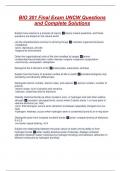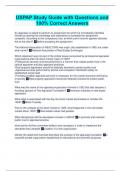Examen
BIO 201 Final Exam UNCW Questions and Complete Solutions
- Grado
- Institución
Explain how science is a process of inquiry inquiry means questions, and these questions are based on the natural world List the characteristics common to all living things -maintain organized structure -metabolize -grow, reproduce, and die -respond to environment Order the organizational units o...
[Mostrar más]




